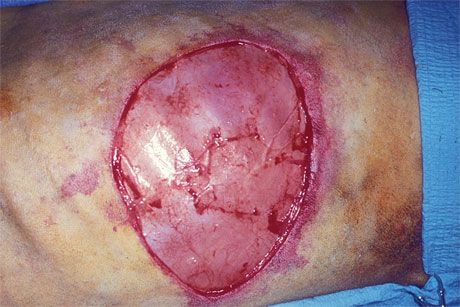Skills Laboratory: Reconstructive surgery techniques, Part 5: Walking sutures
Walking sutures are tension-type sutures that can be used to close large skin defects in areas where sufficient skin surrounds the wound that can be moved or stretched to close the wound.
<Video
|
Step 1>
Walking sutures are tension-type sutures that can be used to close large skin defects in areas where sufficient skin surrounds the wound that can be moved or stretched to close the wound. These sutures are primarily indicated for closing skin defects on the trunks of small animals (Figure 1). Keep in mind that tight skin closure on the thorax can impair respiration, especially in smaller animals. Therefore, thorough preoperative assessment and special care during closure should be taken to avoid this complication.

Figure 1. A large open wound on a dog's lateral thorax.
ADVANTAGES
Most large skin defects on the trunks of dogs and cats can be closed with walking sutures, either using the technique described here or a modification of it. These sutures advance local skin to close large defects without requiring additional incisions to create flaps or attain relaxation. Tension is distributed around the wound rather than concentrating it at the wound edge; thus, the edges can heal without the additional stress of tension. Walking sutures also obliterate dead space because tension on the skin holds it against underlying tissue so no pockets form. Walking sutures create temporary ties between the skin and underlying tissues; however, these disappear in two or three weeks if absorbable suture materials have been used.
POSTOPERATIVE CARE
Place a bandage over the surgical area to prevent wound molestation. Administer systemic analgesia (e.g. a morphine drip) for a few days after surgery. And change bandages periodically to check the status of the surgical area. Remove every other suture (half the sutures) 10 days after surgery. Remove the remaining sutures after 14 days.
Editors' Note: This technique was demonstrated on a canine specimen obtained from a specimen supply company.
ACKNOWLEDGMENT
Thank you to Lori Lind, RVT, Gladstone Animal Clinic, Gladstone, Mo., for her assistance during the demonstration.
Steven F. Swaim, DVM, MS
Professor emeritus
Scott-Ritchey Research Center
Department of Clinical Sciences
College of Veterinary Medicine
Auburn University
Auburn University, AL 36849
SUGGESTED READING
1. Swaim SF, Henderson RA. Small animal wound management. 2nd ed. Baltimore, Md.: Williams & Wilkins, 1997;143-190.
2. Trout NJ. Principles of plastic and reconstructive surgery. In: Slatter D, ed. Textbook of small animal surgery. 3rd ed. Philadelphia, Pa.: Saunders, 2003;274-292.
Step by Step Article


Introduction
Step 3B

Step 4A


Step 1
Step 3C

Step 4B


Step 2
Step 3D

Video


Step 3A
Step 3E